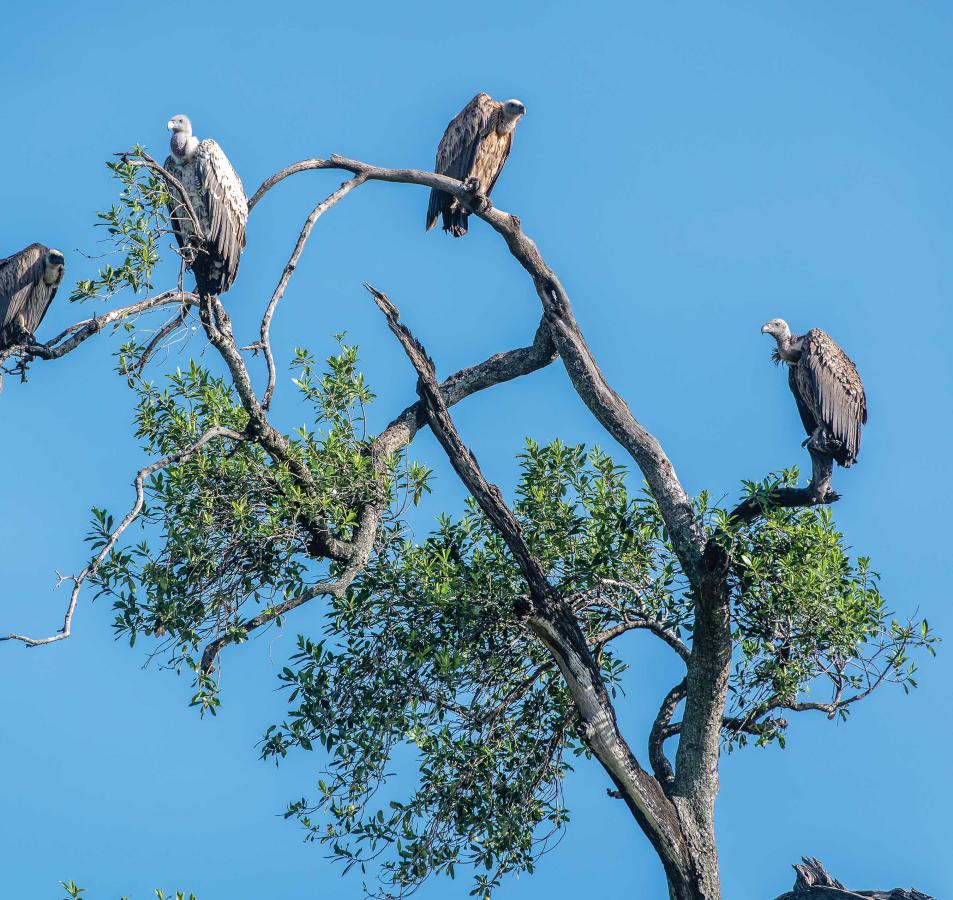When you think about vultures, what comes to mind? Maybe you think they are ominous harbingers of death, or maybe you think of vultures singing Disney-style in a fun but menacing way to a young boy in India (where The Jungle Book takes place). What you may not realize is that Indian vulture populations are all but gone today, and African vultures are following in their footsteps. Why is this alarming? Because vultures are the perfect example of the One Health principle—how animal, human, and environmental health are all interlinked, and how a local issue in African vultures can become a problem for human health around the world.
“Vultures are the clean up crew for dead animals,” said William Bowerman, chair of Environmental Science & Technology (ENST) in AGNR and co-leader of an interdisciplinary group of scientists worldwide seeking to save Africa’s vultures. “Vulture’s stomachs can be very acidic and kill different disease organisms, so they are helping to prevent diseases like anthrax that can run through cattle populations, or even diseases that can spread to humans like the resurgence of rabies in India following vulture declines. The health of the vulture population is directly tied to human health, and as we are dealing with the global pandemic, anything that prevents humans from interacting with dead animals is important. If you have a healthy ecosystem, you have healthy organisms, and you are helping to prevent another issue like COVID-19 from coming up.”
To address rapidly declining African vulture populations and protect their role as nature’s garbage disposals and disinfectors, the National Socio-Environmental Synthesis Center (SESYNC, funded by the National Science Foundation through UMD) has gathered a team led by Bowerman in AGNR, including researchers across the college, university, and around the world.
“This work is vital because we could lose African vultures completely in just a few years,” stressed Bowerman. “Along with myself and four other faculty from AGNR, we have faculty from across UMD and Cornell University, Birdlife International, the Peregrine Fund, Endangered Wildlife Trust, and many others who are all here to solve this international problem collaboratively.
We have issues of poisoning, but also lead and other contaminants, habitat loss, poaching and vulture trade for belief and medicinal use, and other factors that contribute to why the population is dying so quickly and why we need so many different experts.”

Bowerman is a leading expert in raptor research, birds of prey like vultures that serve as indicators of the health of their ecosystems. In fact, Bowerman credits some of the early thinking about the concept of One Health to work groups in the Great Lakes trying to figure out why fish-eating birds were not reproducing in the 1960s, and why deformed birds were popping up in the 1980s (both linked to man made environmental toxins). Developing cause-effect linkages to examine what is happening in an ecosystem is a speciality of Bowerman’s and ENST, offering an ecosystem health specialization.
In addition to Bowerman, the team at UMD includes four AGNR faculty, Jennifer Mullinax, assistant professor in ENST and wildlife ecologist; Reggie Harrell, professor in ENST and conservation ethics expert; Lars Olson, professor in Agricultural & Resource Economics and leader in environmental economics; Mary Ann Ottinger, professor emerita in Animal and Avian Sciences and avian toxicologist; and two faculty members in the College of Behavioral and Social Sciences (BSOS), Jen Shaffer, assistant professor in Anthropology, and Meredith Gore, associate professor in Geographical Sciences and specialist in conservation.
Together, the team hopes to use this work as a foundation to form a new center highlighting the interface between social, environmental, and agricultural issues. For now, however, their focus is publishing and presenting work across a wide range of vulture conservation concerns spanning disease control, habitat preservation, consumption as bush meat, cultural belief use of vulture parts, unintentional poisonings, and even the criminology of intentional poisonings of vultures who might signal the authorities by circling when poachers kill large animals.
“Bringing vulture population declines from intentional poisoning to light in the scientific community raises a heightened awareness of poaching, not only from the targeted animals such as elephants that are killed, but the secondary impact on other species such as vultures, and how all that impacts the socio-ecological-economic health of many peoples and nations,” said Harrell.
“This is a really serious problem,” stressed Gore. “Vultures are ecosystem engineers, and as their population decreases, the second order impacts can harm ecosystems and people. It’s urgent, dynamic, and also really complex. Why should people in Maryland care about what’s happening in Southern Africa? Because it all relates to environmental health. Socio-environmental health relates to socio-environmental security. Global security is national security as the pandemic has shown us.”
The team will be taking over the Journal of Raptor Research in the spring with their latest findings, and plans to present their work on an international scale at the Pan-African Ornithological Congress, a major global platform for conservation held once every four years. As Olson explains it, this is a prime example of collaborative science at work.
“This project is an excellent example of how interdisciplinary team science can produce collaborations that are greater than the sum of the parts and help address the conservation of endangered species subject to multiple threats.” -Lars Olson, Professor, AREC
By Samantha Watters